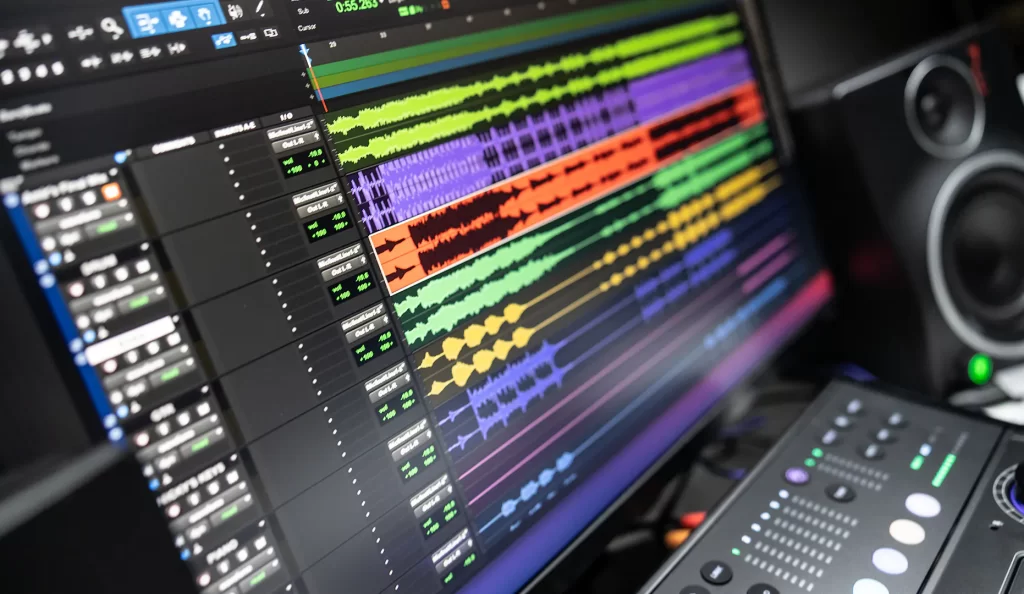Digital sound editing is the process of manipulating audio files using software on a computer or other digital devices. This process involves a variety of tasks, including cutting, splicing, mixing, adjusting levels, applying effects, and restoring or enhancing sound quality. Unlike analog sound editing, which involves physical manipulation of tapes or records, digital sound editing works with digital audio files that can be edited with precision and non-destructively, meaning changes can be made without altering the original file.

Key Aspects of Digital Sound Editing:
1. Audio Capture and Import
The process begins with capturing or importing audio into a digital audio workstation (DAW). Audio can be recorded directly using microphones or imported from other sources like CDs, external recordings, or online sources. This digital audio is typically stored in formats such as WAV, MP3, or AIFF. For more info on DAWs check this link out. Also check out our guide to field recording and foley.
2. Editing and Arrangement
Once audio is imported, the editing process involves trimming unwanted sections, rearranging parts of the audio, and combining multiple tracks. Editors can cut, copy, and paste segments of audio with frame-level precision, allowing for smooth transitions and the elimination of errors or undesired sounds. This is often referred to as audio repair or restoration using tools such as Izotope RX. (Production Expert provides a good overview of the different products available to consumers ).This process is often visually aided by waveforms, which represent the sound amplitude over time, making it easier to locate specific points for editing.
3. Effects and Processing
Digital sound editing allows the application of a wide range of effects and processing techniques. Common effects include reverb, echo, equalization (EQ), compression, and noise reduction. These tools can enhance the quality of the audio, create specific atmospheres, or correct issues like hiss, hum, or distortion. For instance, EQ can adjust the balance of frequencies to make a voice sound clearer or a mix more balanced. For a more detail look at effects please refer to this page.
4. Mixing
Mixing involves combining multiple audio tracks into a single cohesive output. This requires adjusting the levels of each track, panning (placing sound in the stereo field), and ensuring that all elements fit together without clashing or overpowering each other. Mixing also includes the use of effects and dynamic processing to ensure that the final product sounds polished and professional.
For more on mixing including some useful tips and tutorials take a look at this link.
5. Automation and Non-Destructive Editing
Modern DAWs allow for automation, which means that certain parameters, such as volume, panning, or effects, can be adjusted automatically over time within a track. This adds dynamic changes to the audio without manual intervention during playback. Non-destructive editing ensures that the original audio file remains intact, with changes applied only to a copy or in a way that can be reversed or adjusted at any time.
6. Exporting and Mastering:
The final step is exporting the edited audio into a format suitable for its intended use, whether that be a high-quality file for professional distribution or a compressed format for online streaming. Mastering is the final stage of sound editing, where the track is optimized for playback on various systems, ensuring consistent sound quality across different platforms. For more on Mastering visit our page here.
Applications:
Digital sound editing is essential in numerous fields, including music production, film and television post-production, podcasting, radio, video game development, and even forensic audio analysis. Its precision, flexibility, and non-destructive nature make it an indispensable tool in modern audio work.
In conclusion, digital sound editing is a powerful and versatile process that allows for the precise and creative manipulation of audio in ways that were previously unimaginable with analog methods. It is a cornerstone of modern audio production, providing the tools needed to create high-quality sound for a wide range of applications.
